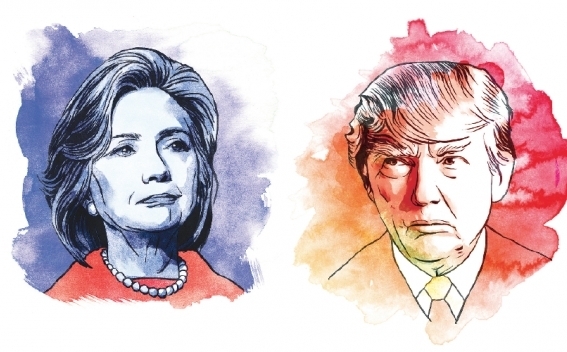 The Secret of Trump's Success
The Secret of Trump's Success

The results of recent US presidential elections came as a surprise to many people. However, many questions receive their answers, when you compare and analyze the results of the elections according to the statistics of voting of different social groups and try to understand the causes of such a choice.
Here we tried to do a similar analysis using the statistics received from the survey conducted by ''Edison Research for the National Election Pool'' (association of several organizations - ABC News, The Associated Press, CBS News, CNN, Fox News and NBC News) after the presidential elections. The survey was conducted in 350 polling stations, including 24 537 people.
Voting According to Revenue
Considering the election statistics on income, we get a pretty interesting picture. It should be noted that if, in other groups, the difference in the voices was mainly big, reaching in some cases 40 percent or more, in this case the biggest difference - 12%, was recorded for those who have an annual income of 30,000 dollars or less (for Clinton - 53%, for Trump - 41%). The difference of numbers of voters is almost indistinguishable, when voters have an annual income of $ 250 000 and above (48% are for Trump and 46% for Clinton). The picture does not change significantly either for people with average income, 50 000 - 99 999 dollars a year (50% are for Trump, 46% for Clinton). 48% of those with an annual income of $ 100 000-199 999 voted for Trump, and 47% for Clinton.
In order to explain such statistics it is enough to refer to the positions of candidates from the Democrats and Republicans on this issue. It is interesting to note that they have, at first glance, completely contradictory positions: Republican candidate Donald Trump is for the establishment of privileged tax conditions for large businesses, and Democratic candidate Hillary Clinton is for increasing taxes for the latter.
Such distribution of votes in the electorate speaks of "two-edged" nature of the proposed solutions. How much contradicting, at first sight, the both proposals are, in case of introduction of any of them, people with both low and high income would benefit.
The establishment of privileged tax conditions for large businesses would make country more attractive for businesses that operate outside the country, on the grounds of their investments in their own country. As a result of which, receiving preferential tax treatment, people with high incomes would surely benefit. On the other hand, people with medium or low incomes could benefit by opening new jobs for them.
Though in the short term Clinton's proposal could seem less beneficial for people with high income, for example, for businessmen, in the long run they would have a guarantee from "migration" of new competitors.
Voting According to Ideology
The results of voting for this category lead to a number of interesting conclusions. For Liberals, the Democratic candidate Hillary Clinton is ahead of Republican candidate Donald Trump (84% of liberals voted for Clinton and only 10% for Trump). For Conservatives, we have the opposite picture: 81% vote for Trump, and 15% for Clinton. Voices of moderated ones were divided almost equally between the candidates: 52% for Clinton, 41% for Trump. Analysis of the results of such a vote is very similar to the analysis of the vote according to the sexes. It also suggests that a large part of the conservative Americans are not yet ready to see a woman president.
Voting According to Religious Groups
Most of the protestants and other Christian groups voted for Trump (58% against and 45% for Clinton). With few exceptions, the picture is the same for Catholics, most of whom also supported Trump (52% against and 39% for Clinton).
Among the Jews the opposite picture is seen (71% for Clinton, while only 24% for Trump). For comparison, in 2008 (78%) and in 2012 (69%) Jews respectively voted for the Democratic candidate - Barack Obama. It is likely because of the position of both Clinton and Obama concerning Palestinian conflict.
In the case of other religious groups, Clinton is ahead of her opponent. In this group, 68% of voters support her and only 26% support Trump. In this group there are also Muslims, less than 1% of which have the right to vote in USA. Thus it was difficult for researchers to identify their vote in separate statistics.
The results of the vote of religious groups also have their explanation. Trump's whole campaign was built on contradictions between religious groups.
Summarizing, we can come to the following conclusion: Trump, throughout his campaign was able to make maximum use of the protest voters, successfully playing on the contradictions between the various segments of the population. Going against women, he directly opposed the idea of having a woman president, which could not fail to impress a pretty large number of voters with conservative views. Speaking against the migrants, he lured to his side the part of the electorate, which for many years considered themselves affected by illegal immigration. Speaking against African-Americans, he was largely supported by white voters, who constitute the majority of the voters. The list of such contradictions, of course, can be continued...
Other materials on this subject
- Turkey is sending Cold War-era cluster bombs to Ukraine – FP The weapons are designed to destroy tanks by bursting into smaller submunitions, which can linger on the battlefield for years if they do not immediately explode. Each round scatters about 88 bomblets.
- Los Angeles mayor and city council president address US president on Lachin corridor issue Thank you, Mayor Bass, for joining me in communicating to President Biden the urgent need for U.S. leadership to lift the blockade and bring humanitarian relief to the people of Artsakh.
- US Committed to Helping Armenia and Azerbaijan Resolve Issues Peacefully: Blinken Spoke With Pashinyan The Secretary reiterated our commitment to helping Armenia and Azerbaijan resolve issues peacefully.
- Iran to Submit Final Conclusion Over Nuclear Deal Revival by Midnight In comments on Monday, Amirabdollahian said Iran is going to send its final conclusion about the JCPOA talks to the European coordinator in written form at midnight.
- Erdogan, Biden Might Meet in September- Media Turkey plans to buy 40 F-16 fighter jets from the US and upgrade another eighty. US President Joe Biden stated that he expects to receive the approval of the [US] Congress to sell F-16 fighter jets to...
Other materials on this subject
- Around 25 Domestic Terrorism Cases Opened in US after Congress Storming About 25 cases of domestic terrorism were opened in the US following the unrest caused by supporters of US President Donald Trump in the Capitol building.
- Former New York City Mayor Mike Bloomberg Eyeing Presidential Bid He has not decided whether to run for president but is back to actively considering it and is taking this step to keep his options open.
- Putin: Trump Opponents Harm US with 'Invented' Russia Scandal Putin said the US opposition was not treating those who elected Mr. Trump with respect.
- Is Trump’s Replacement Realistic? However, how are the congressmen going to prove that Donald Trump is "incapacitated"?
- Will Putin-Trump Romance End Soon? ...to fully understand the logic of Trump’s policy towards Russia, it is helpful to get acquainted with the logic of deal-making introduced by Trump in his book entitled "The Art of the Deal'.
-
 17:08
17:08The regular session of the Anti-corruption Policy Council takes place in Jermuk
-
 15:05
15:05The Prime Minister sends congratulatory messages to the supreme leader of Iran and the President of Iran
-
 11:11
11:11Armenia sends earthquake aid to Turkey
-
 10:43
10:43Commemoration of the Pontiff St. Sahak Partev
-
 09:16
09:16Some roads are closed and difficult to pass in Armenia
-
 19:55
19:55Phone conversation of the Foreign Minister of Armenia with the U.S. Assistant Secretary of State for European and Eurasian Affairs
-
 18:30
18:30Prime Minister Pashinyan and President Khachaturyan meet
-
 18:20
18:20Ararat Mirzoyan with Co-Chairman of the OSCE Minsk Group of France Brice Roquefeuil
-
 17:01
17:01Humans could land on Mars within 10 years, Musk predicts
-
 16:45
16:45France, US urge 'immediate' end to Nagorno Karabakh blockade
-
 16:01
16:01Blockaded Nagorno Karabakh launches fundraiser to support quake-hit Syria
-
 15:59
15:59Earthquake death toll in Turkey rises to 18,342
-
 15:43
15:43Ararat Mirzoyan Held a Telephone Conversation with Sergey Lavrov
-
 15:06
15:06French president rules out fighter jet supplies to Ukraine in near future
-
 14:47
14:475 Day Weather Forecast in Armenia
-
 14:44
14:44President Vahagn Khachaturyan wrote a note in the book of condolences opened in the Embassy of Syria in Armenia
-
 14:20
14:20Azerbaijan’s provocations impede establishment of peace and stability – Armenian FM tells Russian Co-Chair of OSCE MG
-
 12:57
12:57France representation to OSCE: Paris calls on Azerbaijan to restore freedom of movement through Lachin corridor
-
 11:40
11:40Command of Kosovo forces highly appreciated preparation of Armenian peacekeepers
-
 10:16
10:16The United States withdrew from sanctions against Syria for six months the provision of assistance after the earthquake
day
week
month
Humidity: %
Wind: km/h









